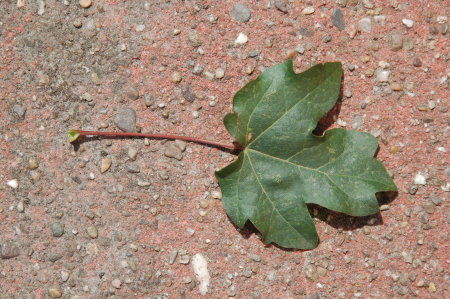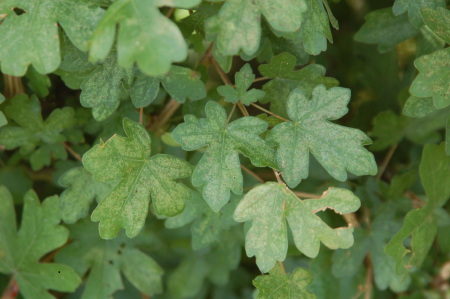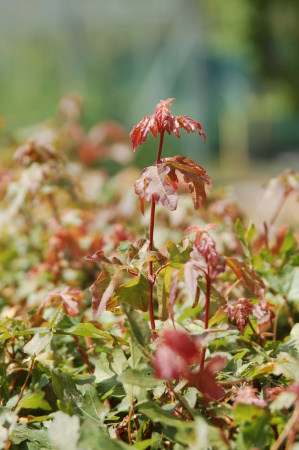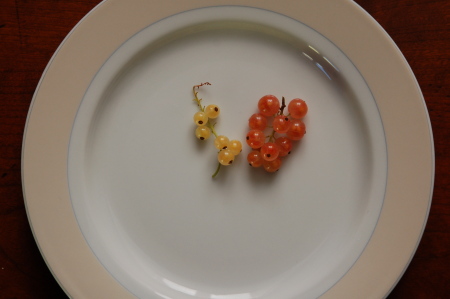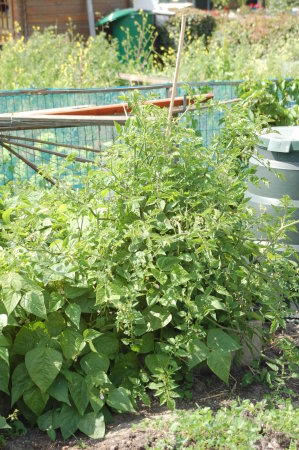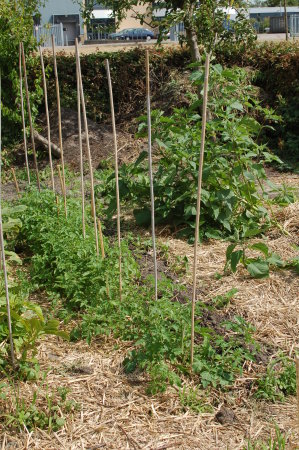It’s always hard to take pictures of my garlic plants, because I have so many of them growing close together, but in the middle of this picture (the plants with their base at the bottom center) are some of my rustiest plants. This is Kransnodar White garlic. Kransnodar is a city in Siberia, and I think it was famous for it’s garlic in Soviet days. In a few days these plants will be dead for sure, but I may still be able to harvest something from them.
I remember from last year this variety got rust badly too, and the bulbs I harvested were on the small side.
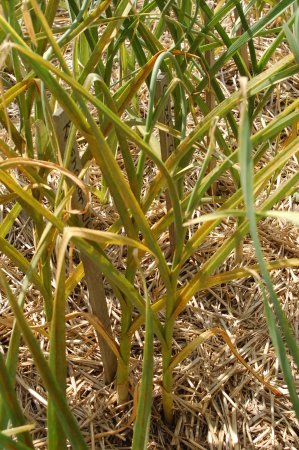
Another variety getting bad rust is Tuscan, an Italian variety:
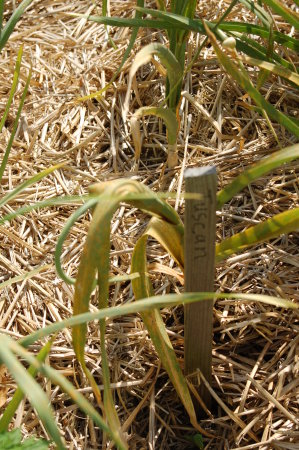
These pictures don’t have enough resolution to see it clearly, but it looks like these plants have pox or something. They are covered in lots of small brown spots.
I would say in general the rust seems worse than last year, but it’s still too early to say how bad it really is. I’m so close to harvest, that every week the plants stay alive is very important. These two pictures represent the worst, and most of my garlic really seems to be doing okay for the moment. The severity of the rust seems to depend on the location in the garden, as well as the variety. I’m learning the quality of soil in my garden varies greatly from spot to spot, and it’s clear that has an impact on the severity of the rust. Exactly what the factors are behind this is less than clear however.
It’s been my intention to reduce the number of varieties I have, so any that get particularly bad rust which are not otherwise interesting, will probably get discarded.
Now I’m waiting for the potato blight to arrive. It’s getting to be about time for that too!
Dry and Windy Weather
It’s been very dry recently. Not particularly hot, but the wind is really drying out the ground. Established plants in my garden don’t need a lot of watering, because while the water table is going down a bit in this weather, it’s not too far down and anything with deep roots can reach it. I’ve recently planted some beans and a few other seeds, and it’s been a challenge to keep them wet enough to germinate, because the ground is so sandy every time I add water it just drains through. Parts of my garden are even rich with seashells!
So far the only victim of the wind were a few of my Jerusalem artichoke plants, but I guess these will grow back.
This dry weather has really given me a different perspective on the soil of my garden. Beside noticing how sandy it is, I’ve been noticing anything that’s not growing next to beans has not been doing very well, which seems to go along with my soil test of a few months ago that showed a general lack of nitrogen. It’s also just increasingly clear the ground is very lacking in organic material. I have really added a lot of compost in recent months brought from my previous garden, but it has not really had a lot of time to become incorporated and more would probably help.
I’ve noticed the ground in my garden is mostly ‘dead’. There are very few worms or insects living in it, with the exception of a lot of ants.
If you are a commercial farmer (at least in this part of the world), the ideal situation is ‘dead’ ground. Organic material is usually not desirable, and is best avoided when possible. Pure clay, silt or sand, or some mixture of these three is the best. The reason for this is farmers have a system of growing crops with chemicals that works very well for them, and if the ground is ‘dead’ there are simply fewer variables for them to deal with. The nutrient balance of the ground (or perhaps the complete lack of nutrients) is generally known in advance so a preset amount of fertilizer can be added. Most chemical fertilizers don’t remain in the ground for more than a growing season, because they are water soluble, so every year you are starting fresh. All of the pests and diseases are mostly known quantities, and there are chemicals available to deal with these.
It’s part of the culture here that individual thinking is not encouraged, and there is often a social price to be paid if you think and act differently than others. Perhaps in part for this reason, most people here seem to take the same approach with gardening that farmers take, and prefer ‘dead’ ground with chemicals added. It’s certainly an issue that divides people mostly according to nationality in my garden complex, with compost being made and used mostly by non-Dutch born gardeners, and the point of some contention. Since the previous gardener was Dutch-born, it’s logical to think the approach he took was to promote dead ground, but I don’t know for sure.
It’ll be interesting to see how my garden changes as I add more organic material, and try to promote more life processes in the soil. I’m curious how long it will take before I notice real changes.
